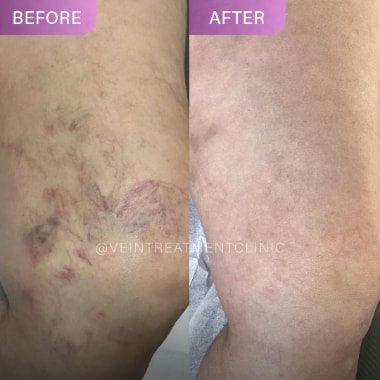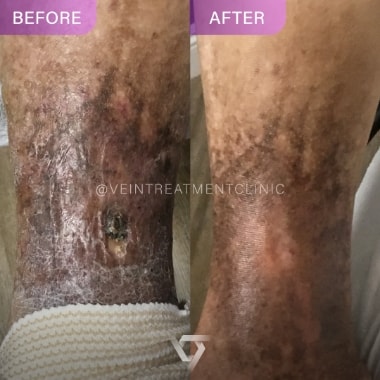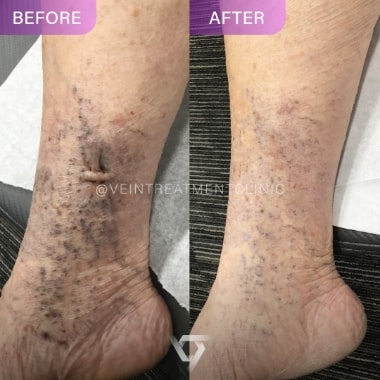Vein diseases
Signs and symptoms of vein disease are typically mild in the early stages. However, leg soreness tends to get worse with time and potentially more serious issues can arise.

Treated spider veins

Treated varicose veins
Leg Ulcers
Leg vein ulcers are a late symptom of venous illness that can seriously affect your life and health. The same vein issues that produce varicose veins also result in vein ulcers brought on by high blood pressure in the veins. Leg swelling, cramping, itching, weariness, and leg heaviness are the early signs of varicose vein disease. Later stages of vein disease include skin changes, eczema, thickening skin, and skin ulceration as the illness progresses.

Treated leg ulcers

Treated leg ulcers
Venous Insufficiency
Varicose veins, commonly referred to as “Varicosities,” are swollen, diseased veins that typically develop due to excessive pressure in deeper veins in the leg. Varicose veins can bulge from beneath the skin and might be tortuous or twisted. Varicose veins can occur anywhere on the body and are most frequently observed on the legs, where they typically appear red or purple.
Varicose vein disease is more likely to affect women than men for a variety of reasons, including familial history, obesity, advanced age, pregnancy, immobility, previous blood clot history, and gender.
Varicose Veins
Varicose veins, commonly referred to as “Varicosities,” are swollen, diseased veins that typically develop due to excessive pressure in deeper veins in the leg. Varicose veins can bulge from beneath the skin and might be tortuous or twisted. Varicose veins can occur anywhere on the body and are most frequently observed on the legs, where they typically appear red or purple.
Varicose vein disease is more likely to affect women than men for a variety of reasons, including familial history, obesity, advanced age, pregnancy, immobility, previous blood clot history, and gender.
Spider Veins
Telangiectasias, or spider veins, are collections of microscopic blood vessels that develop near the skin’s surface. They come in blue, red, or purple hues. Although they can appear anywhere, the face and legs are where they frequently do.
Spider veins are more common in people over the age of 50 than in younger people. Varicose veins and spider veins have a lot in common. Although varicose veins are more prominent on average than spider veins, they can occasionally be found simultaneously.
Spider veins can cause throbbing, swelling, and restless legs and be asymptomatic (painless).
Many things might cause spider veins. These risk elements consist of the following: older age, pregnancy, obesity, hormone therapy (HT), lengthy periods of standing or sitting, birth control, and family history.
Leg Cramps
Leg cramps, commonly called charley horses, happen when one or more of your leg muscles tighten forcibly and against your will. Leg cramps usually are not harmful, but if they occur frequently, they can disrupt the quality of life and make it temporarily hard to use the affected leg.
Leg cramps can be brought on by prolonged exertion or physically demanding activities, particularly in hot temperatures. Venous insufficiency is the most frequent cause of recurrent leg cramps, and treating leg cramps necessitates addressing the underlying vein disease.
Leg Swelling
Peripheral edema, another name for leg swelling, is brought on by an unusual fluid buildup in the lower extremities’ tissues. Due to gravity, it frequently shows up more clearly in the lower parts of the body. The majority of leg edema occurs in older persons.
Salt retention, pregnancy, congestive heart failure, cellulitis, venous insufficiency, and drug side effects are among the common reasons for leg edema.
The best strategy to treat leg swelling is to deal with the underlying problem. Leg swelling can be addressed with conservative techniques like wraps or compression stockings.
Leg Heaviness
Numerous conditions can result in leg heaviness, but the most frequent one is chronic venous insufficiency, a circulation condition affecting the legs’ veins.
Leg heaviness caused by venous disease usually worsens after extended periods of sitting or standing. Symptoms typically get better with exercise and get worse with heat.
Consider visiting a skilled vein doctor to assess venous insufficiency if you have experienced leg heaviness at the end of the day, especially if you have visible spider and varicose veins on the skin’s surface.
Restless Leg Syndrome
The hallmark of restless legs syndrome (RLS) is a continuous urge to move the legs. Because it can disrupt sleep, it is frequently seen as a sleep disorder. Long periods of sitting or standing are often the cause.
Both men and women can get restless legs syndrome, but women are more likely to get it. At any age, it can begin. Adults in their middle or later years make up most of those severely impacted.
Your attitude, concentration, performance at work or school, and personal relationships may all be negatively impacted by restless legs syndrome, which can also lead to daytime sleepiness and weariness. Most RLS sufferers report having poor memory, finding it difficult to focus, or even struggling to complete chores.
Consider getting evaluated by a skilled and experienced vein doctor if you have symptoms of restless leg syndrome and visible veins. This condition may be caused by underlying venous insufficiency.

